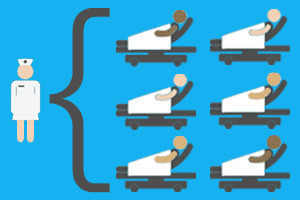
During hospital and healthcare facility risk assessments around the country, we often hear nurses’ feedback about staffing challenges and heavy workloads. Is this perception or is it a reality that nurse staffing levels are impacting safety?
News reports and lawsuits related to nurse staffing issues suggest the problem is more than perception. It is important for risk and safety managers to be aware of staffing concerns in order to support nurses and help hospital management develop solutions. Identifying and maintaining an appropriate number and mix of nursing staff is critical to the delivery of safe patient care. At the same time, reductions in nursing budgets have resulted in fewer nurses working longer hours caring for sicker patients – and the problem may continue to increase as hospitals face challenges in recruiting and retaining adequate numbers of qualified nursing and other staff into the next decade and possibly longer.
Research suggests that improved nurse staffing has a beneficial effect on patient outcomes. Conversely, research shows that the likelihood of patient mortality in the hospital following a complication associated with failure to rescue increases by 7% for each additional patient added to the average registered nurse workload. A similar study focused on in-hospital cardiac arrest found a 4% decrease in the odds of survival for patients on hospital medical-surgical units with each additional patient per nurse.
Legislation requiring adequate nurse staffing at state and federal levels has been introduced in both the House and the Senate. The Registered Nurse Safe Staffing Act of 2014 (S. 2353) was introduced in the U.S. Senate on May 15, 2014 and was referred to the Committee on Finance. The bill requires unit-by-unit staffing plans and public reporting of the plans, but does not impose nurse-patient ratios. It also provides whistleblower protections for nurses and others who file a complaint for inadequate staffing. Additionally, some state boards of nursing have adopted rules of practice to protect nurses who believe they have been given an unsafe assignment. Currently, fifteen states and the District of Columbia have enacted legislation and/or adopted regulation to address nurse staffing.
How can hospitals and healthcare professional organizations address concerns about staffing shortages? In its report Workforce 2015: Strategy Trumps Shortage, the American Hospital Association (AHA) Long-Range Policy Committee developed recommendations and strategies that include:
- Hospital work redesign to maximize efficiency, effectiveness and staff satisfaction
- Retention of existing workers, some of whom are near retirement
- Attracting a new generation of workers to replace a large group of retiring workers
Redesigned work models are most successful when developed by nursing staff at the bedside in collaboration with leadership and consider patient care needs, staff skills competencies and hospital characteristics. In 2003, the Institute for Healthcare Improvement and the American Organization of Nurse Executives launched the Transforming Care at the Bedside Project (TCAB), funded by The Robert Wood Johnson Foundation, in an effort to improve hospital patient care and work environment by empowering front-line nurses to implement innovative practices on their units. Since that time, hospitals across the country and internationally are now applying TCAB principles and processes in their work. A toolkit containing best practice policies to involve staff, generate ideas and set goals to increase excellence of care and efficiency was created by 10 hospitals that participated in TCAB.
The Workforce 2015: Strategy Trumps Shortage report also encourages adoption of tools such as TeamSTEPPS to improve communication and support redesigned healthcare teams to accomplish work in a more effective and efficient way. Sedgwick’s Healthcare Risk Management team provides TeamSTEPPS training and coaching for teams in hospitals, long-term care and outpatient facilities and physician practices.
Whether perception or reality, hospital staffing concerns must be heard and resolved. Research demonstrates the strong correlation between lower nurse-to-patient ratios and improved patient and nurse satisfaction, better care outcomes and error reduction. Risk and safety leaders have an opportunity to collaborate with nurses at the bedside to create innovative strategies and develop solutions to build a safer environment for patients and nurses.
Ann Gaffey, RN, MSN, CPHRM, DFASHRM, SVP, Healthcare Risk Management and Patient Safety and Cynthia Hartsfield, BSN, RN, MA, CPHRM, contributor and former Sedgwick Healthcare Risk Management Consultant